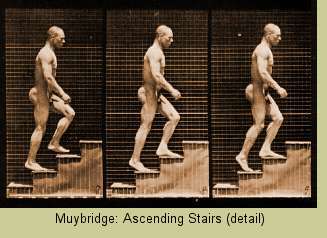
Sound and Technology from the Artist's Perspective
042200.08 Digital Images and ImaginingsWhen you describe art, you are also describing how meaning is produced and subjectivity formed. In other words, you are describing reality. Joseph Kosuth
Technology has increased the ability to manipulate, distribute and access the image. Scanners, imaging software, color printing and photo-copying, CD-ROM, DVD and especially the internet have escalated the bombardment of images that every day command our attention. Images of all imaginable sorts are the common currency of the internet-connected business place. They run as workplace-related topics, good and bad jokes, sex, politics, advertising - whatever the tastes of the creator/procurer and their circles may be. These images appear on a daily basis, make their rounds, have a very short life and virtually disappear, perhaps to reappear only briefly when another group latches on and re-circulates them. The image proliferates partly because of the desktop capability of comical or grotesque manipulation. But the subtlety also available in manipulation should not be discounted. In everyday images what we see is not necessarily what truly was. The image is 'cleaned up,' lighting changed, color 'corrected,' file size compressed. Any number of other manipulations occur, all in the name of producing a 'professional' product. To be sure, there is a difference between artwork and journalism, but still on this new frontier each must create her/his own ethics about what is process-oriented for display purposes, and what is 'truth in advertising' and accurate reportage. In an era when the image may be manipulated seamlessly, what constitutes the actuality - the image in the editor's imagination or the image actually captured?
Copyright © 22 April 2000 Jeff Talman, New York City, USA
|

 Let's wipe the slate clean. Language describes image: the slate being wiped. With that statement few actually think of the slate being cleaned, other meaning is implicit. As with language so with image itself. A subtext, a lingua franca of idea follows image as inexorably as the mind creates connections between any A and B. A woman eating an ice cream cone, trash blowing across a vacant lot on a gray day, a solitary man confronting a tank: advertisers, artists, the media recognize the power of the image as a prime tool of communication, one that goes beyond the literal. At least since Magritte we have known that 'this is not a pipe.'
Let's wipe the slate clean. Language describes image: the slate being wiped. With that statement few actually think of the slate being cleaned, other meaning is implicit. As with language so with image itself. A subtext, a lingua franca of idea follows image as inexorably as the mind creates connections between any A and B. A woman eating an ice cream cone, trash blowing across a vacant lot on a gray day, a solitary man confronting a tank: advertisers, artists, the media recognize the power of the image as a prime tool of communication, one that goes beyond the literal. At least since Magritte we have known that 'this is not a pipe.'